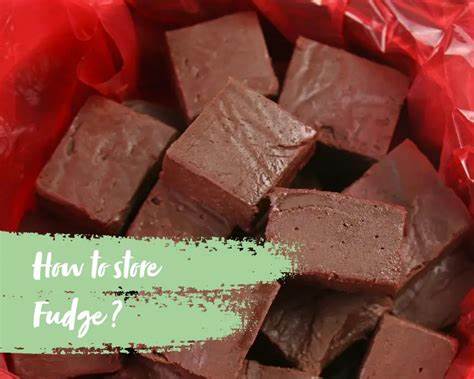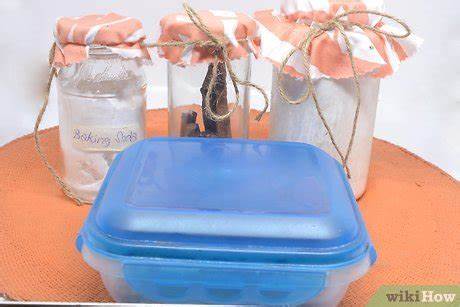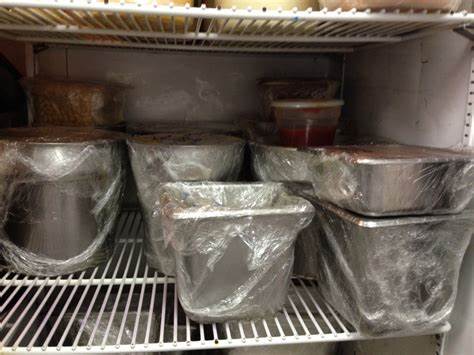Contents
- 1 Introduction to Storing Fudge
- 2 Factors Influencing Fudge Storage
- 3 Best Practices for Storing Fudge
- 4 Duration of Fudge Storage
- 5 Strategies for Maintaining Fudge Quality
- 6 Special Considerations for Different Types of Fudge
- 7 Tips for Reviving Stale or Dry Fudge
- 8 Common Mistakes to Avoid When Storing Fudge
- 9 Conclusion
Introduction to Storing Fudge
Fudge, with its rich, creamy texture and decadent flavor, is a beloved treat enjoyed by people of all ages and backgrounds. Crafted from a harmonious blend of sugar, butter, milk, and flavorings, fudge holds a special place in the hearts of dessert enthusiasts worldwide. However, to preserve its delectable qualities and extend its shelf life, proper storage techniques are paramount.
Understanding the nuances of fudge storage is essential for maintaining its freshness, texture, and flavor profile. Whether homemade or store-bought, fudge is susceptible to various environmental factors that can affect its quality over time. From temperature fluctuations to exposure to air and light, each element plays a crucial role in determining the longevity and enjoyment of this beloved confection.
In this comprehensive guide to storing fudge, we explore the intricacies of fudge storage, from the ingredients used to its ideal storage conditions. By delving into the science behind fudge preservation and sharing practical tips for maintaining its quality, we aim to empower fudge enthusiasts with the knowledge and tools necessary to savor every bite of this indulgent treat.
Join us on a journey through the world of fudge storage as we uncover the secrets to keeping this delectable confection fresh, flavorful, and irresistible. From short-term storage solutions to long-term preservation techniques, we delve into the strategies that ensure your fudge delights your taste buds long after it’s made.
Whether you’re a seasoned fudge aficionado or a novice confectionery enthusiast, understanding the importance of proper fudge storage is key to unlocking its full potential. Let’s embark on this exploration together, celebrating the art and science of preserving one of life’s sweetest pleasures: fudge.
Factors Influencing Fudge Storage
The quality and longevity of stored fudge are influenced by a variety of factors, each playing a crucial role in determining its overall freshness and palatability. Understanding these factors is essential for implementing effective storage practices and preserving the integrity of this delectable treat.
Ingredients Used in Fudge:
Fudge is typically composed of simple yet indulgent ingredients, including sugar, butter, milk, and flavorings such as chocolate, vanilla, or nuts. The quality and freshness of these ingredients directly impact the shelf life and flavor profile of the fudge. Using high-quality, fresh ingredients enhances the overall taste and texture of the fudge and contributes to its longevity when stored properly.
Temperature and Humidity:
Temperature and humidity levels play a significant role in fudge storage, as fluctuations in these environmental factors can accelerate spoilage and affect texture. Fudge should be stored in a cool, dry place away from direct sunlight and heat sources, as exposure to warmth can cause melting and undesirable texture changes. High humidity levels can also lead to moisture absorption, resulting in a sticky or grainy texture.
Exposure to Air and Light:
Exposure to air and light can compromise the quality and flavor of stored fudge over time. Oxygen exposure can lead to oxidation, causing the fudge to develop off-flavors and lose its freshness. Similarly, exposure to light, especially ultraviolet (UV) light, can accelerate the degradation of fats and proteins in the fudge, resulting in rancidity and discoloration.
By understanding the influence of these factors on fudge storage, individuals can implement proactive measures to mitigate potential risks and preserve the quality of their beloved confection. From selecting high-quality ingredients to controlling storage conditions, each step contributes to ensuring that fudge remains a delectable treat for indulgence and enjoyment.
Best Practices for Storing Fudge
Ensuring optimal storage conditions is essential for preserving the freshness, texture, and flavor of fudge over time. By adhering to best practices for fudge storage, individuals can extend the shelf life of this indulgent treat and maintain its irresistible qualities for longer periods. Below are key guidelines for storing fudge effectively:
Choosing the Right Container:
Selecting an appropriate container is the first step towards successful fudge storage. Opt for airtight containers made of glass or plastic with tight-fitting lids to prevent air and moisture from infiltrating the fudge. Avoid containers with porous materials or inadequate seals, as they may compromise the quality of the stored fudge.
Proper Sealing Techniques:
Sealing the fudge container securely is crucial for maintaining its freshness and texture. Ensure that the container is tightly sealed to prevent air exposure and minimize the risk of moisture absorption. Consider using plastic wrap or parchment paper to create an additional barrier between the fudge and the container lid, further enhancing its protective seal.
Ideal Storage Conditions:
Fudge should be stored in a cool, dry place with stable temperature and humidity levels. Ideally, store fudge in a pantry or cupboard away from heat sources, sunlight, and moisture-prone areas such as the kitchen sink or stove. Avoid storing fudge in the refrigerator unless explicitly instructed, as refrigeration can alter its texture and flavor.
Temperature:
Maintaining a consistent temperature is essential for fudge storage. Aim for temperatures between 60°F to 70°F (15°C to 21°C) to prevent melting or crystallization. Avoid storing fudge in areas prone to temperature fluctuations, such as near windows or heating vents, as this can compromise its quality.
Humidity Levels:
Controlling humidity levels is equally important for fudge storage. High humidity can lead to moisture absorption and undesirable texture changes, while low humidity can cause fudge to dry out and become crumbly. Aim for moderate humidity levels (around 50% to 60%) to keep fudge fresh and supple.
Avoiding Direct Sunlight:
Exposure to direct sunlight can accelerate the degradation of fudge, causing it to melt, lose its shape, and develop off-flavors. Store fudge in opaque containers or dark-colored wrapping to shield it from harmful UV rays and preserve its integrity.
By following these best practices for fudge storage, individuals can prolong the shelf life of their favorite confectionery treat and enjoy its delectable qualities for weeks or even months. With proper care and attention to detail, fudge can remain a delightful indulgence for every occasion.
Duration of Fudge Storage
Understanding the optimal duration for storing fudge is crucial for maintaining its freshness and quality over time. While fudge is renowned for its decadent texture and rich flavor, it is also susceptible to changes in texture and taste when stored for extended periods. Here are key considerations regarding the duration of fudge storage:
Short-term Storage Guidelines:
For short-term storage, fudge can be kept at room temperature in an airtight container for up to two weeks. During this time, the fudge retains its freshness and flavor, making it ideal for immediate consumption or sharing with friends and family. Follow proper sealing and storage practices to prevent exposure to air and moisture, which can hasten spoilage.
Long-term Storage Considerations:
When planning to store fudge for longer periods, it is essential to take additional precautions to preserve its quality. Fudge can be stored in the refrigerator for up to one month or in the freezer for up to three months, provided it is properly wrapped and sealed to prevent freezer burn and flavor absorption from other foods.
Shelf Life of Fudge:
The shelf life of fudge varies depending on factors such as ingredients used, storage conditions, and exposure to air and light. While commercially prepared fudge may come with expiration dates, homemade fudge may not have clear guidelines for shelf life. As a general rule, fudge should be consumed within a reasonable timeframe to ensure optimal taste and texture.
Regularly assess the appearance and aroma of stored fudge to determine its freshness and suitability for consumption. Discard any fudge that shows signs of spoilage, such as mold growth, off-putting odors, or changes in texture or color.
By adhering to recommended storage durations and guidelines, individuals can enjoy fudge at its peak freshness and flavor, whether it’s for immediate enjoyment or planned indulgence in the future. With proper storage practices and attentive monitoring, fudge can remain a delightful treat for every occasion, bringing joy and satisfaction to those who savor its irresistible allure.
Strategies for Maintaining Fudge Quality
Preserving the quality of fudge requires proactive strategies to prevent moisture absorption, flavor transfer, and texture degradation. By implementing these strategies, individuals can ensure that their stored fudge maintains its freshness, flavor, and indulgent texture for an extended period. Here are key strategies for maintaining fudge quality:
Preventing Moisture Absorption:
Moisture is the enemy of fudge storage, as it can lead to undesirable texture changes and promote the growth of mold and bacteria. To prevent moisture absorption, ensure that the fudge is properly sealed in an airtight container or wrapped tightly in plastic wrap or parchment paper. Store fudge in a cool, dry place away from sources of humidity, such as the kitchen sink or dishwasher.
Minimizing Flavor Transfer:
Fudge has a unique and indulgent flavor profile that can be compromised by exposure to strong odors and flavors from other foods. To minimize flavor transfer, store fudge in a separate container or compartment away from pungent-smelling foods such as onions, garlic, and spices. Consider using odor-absorbing materials such as baking soda or activated charcoal to neutralize any unwanted odors in the storage area.
Avoiding Temperature Fluctuations:
Temperature fluctuations can adversely affect the texture and consistency of stored fudge, leading to melting, crystallization, or texture changes. To avoid temperature fluctuations, store fudge in a stable environment with consistent temperatures, ideally between 60°F to 70°F (15°C to 21°C). Avoid storing fudge near heat sources or in areas prone to temperature fluctuations, such as the oven or refrigerator door.
Regularly Monitor Storage Conditions:
Regularly monitor the storage conditions of fudge to ensure that it remains fresh and free from spoilage. Check the container or wrapping for any signs of moisture buildup, mold growth, or changes in texture or color. If any abnormalities are detected, promptly discard the affected portion of the fudge to prevent contamination of the rest.
By incorporating these strategies into fudge storage practices, individuals can maintain the quality and integrity of their favorite confectionery treat, ensuring that it remains a delightful indulgence for every occasion. With proper care and attention to detail, stored fudge can retain its irresistible allure and bring joy to those who savor its decadent flavor and texture.
Special Considerations for Different Types of Fudge
Various types of fudge offer unique flavor profiles and ingredient compositions, each requiring special considerations for storage to maintain their quality and freshness. Understanding these considerations is essential for preserving the distinct characteristics of different fudge varieties. Here are special considerations for storing different types of fudge:
Chocolate Fudge:
Chocolate fudge, with its rich cocoa flavor and creamy texture, requires careful storage to prevent melting and flavor loss. Store chocolate fudge in a cool, dry place away from direct sunlight and heat sources to prevent melting and maintain its chocolatey goodness. Consider wrapping chocolate fudge in parchment paper or foil before placing it in an airtight container to provide an additional layer of protection against moisture and odor absorption.
Nutty Fudge Varieties:
Fudge varieties containing nuts, such as walnut fudge or pecan fudge, require special attention to prevent rancidity and maintain nutty freshness. Nuts contain oils that can become rancid when exposed to air and light over time. To preserve the freshness of nutty fudge varieties, store them in an airtight container in a cool, dark place. Consider adding a desiccant packet to absorb excess moisture and extend the shelf life of the fudge.
Dairy-Free and Vegan Fudge Options:
Dairy-free and vegan fudge options, which often use alternative ingredients such as coconut milk or almond butter, may have different storage requirements compared to traditional fudge recipes. While these fudge varieties offer dairy-free indulgence, they may be more susceptible to texture changes and flavor loss when exposed to moisture or temperature fluctuations. Store dairy-free and vegan fudge options in airtight containers in the refrigerator to maintain freshness and prevent spoilage.
Consider the specific ingredients and characteristics of each fudge variety when determining the optimal storage conditions. Regularly inspect stored fudge for any signs of spoilage or texture changes, and discard any portions that show signs of deterioration. With proper storage and handling, different types of fudge can retain their irresistible flavor and texture, bringing joy to those who savor their indulgent goodness.
Tips for Reviving Stale or Dry Fudge
Occasionally, stored fudge may become stale or dry due to prolonged exposure to air or fluctuations in storage conditions. While this can affect its texture and flavor, there are several simple techniques for reviving stale or dry fudge and restoring its irresistible qualities. Here are tips for reviving stale or dry fudge:
Microwave Method:
Place the stale or dry fudge on a microwave-safe plate and microwave it on low power for short intervals, such as 10 to 15 seconds at a time. Check the fudge after each interval to prevent overheating and monitor its texture. The gentle heat from the microwave helps soften the fudge and restore its moisture content without melting it entirely.
Steam Rejuvenation Technique:
Alternatively, steam can be used to revive stale or dry fudge by reintroducing moisture into the confection. Place the fudge in a heatproof container or bowl and set it over a pot of simmering water. Allow the steam to permeate the fudge for several minutes, periodically checking its texture and adding more steam as needed. Once the fudge has softened to the desired consistency, remove it from the steam and let it cool before serving.
Adding Moist Ingredients:
For fudge that has become excessively dry, consider incorporating moist ingredients such as marshmallows, cream, or condensed milk to restore its softness and moisture content. Break the stale fudge into small pieces and mix it with the moist ingredients in a heatproof bowl. Heat the mixture gently over low heat, stirring continuously until the fudge has softened and the ingredients are well combined. Allow the mixture to cool and set before cutting it into pieces and serving.
By employing these simple techniques, individuals can breathe new life into stale or dry fudge and enjoy its indulgent flavor and texture once again. Experiment with different methods to find the one that works best for reviving your favorite fudge varieties, and savor the delight of freshly rejuvenated confections. With a little creativity and patience, even the driest fudge can be transformed into a delectable treat worth savoring.
Common Mistakes to Avoid When Storing Fudge
While storing fudge may seem straightforward, certain common mistakes can compromise its freshness, texture, and flavor. By being aware of these pitfalls and avoiding them, individuals can ensure that their fudge remains a delightful indulgence for longer periods. Here are common mistakes to avoid when storing fudge:
Using Improper Containers:
Choosing the wrong container for storing fudge can lead to air exposure, moisture absorption, and flavor transfer. Avoid using containers made of porous materials or those with loose-fitting lids, as they may fail to provide adequate protection against external elements. Opt for airtight containers made of glass or plastic with tight-sealing lids to maintain the freshness and integrity of the fudge.
Excessive Handling:
Excessive handling of fudge can result in unwanted texture changes and promote the growth of bacteria. Handle fudge with clean hands or utensils to prevent contamination and preserve its quality. Minimize unnecessary touching and rearranging of stored fudge to avoid unnecessary exposure to air and moisture.
Inadequate Sealing:
Proper sealing is essential for preserving the freshness and texture of stored fudge. Inadequately sealed containers or wrapping can allow air and moisture to infiltrate the fudge, leading to spoilage and flavor loss. Ensure that the container or wrapping is tightly sealed to create a protective barrier against external elements.
Storing Fudge in Inappropriate Environments:
Storing fudge in environments prone to temperature fluctuations, high humidity, or direct sunlight can accelerate spoilage and compromise its quality. Avoid storing fudge near heat sources, such as ovens or stovetops, and opt for cool, dry places with stable temperature and humidity levels. Shield fudge from direct sunlight to prevent heat-induced melting and flavor degradation.
By avoiding these common mistakes when storing fudge, individuals can prolong its shelf life, maintain its freshness, and enjoy its indulgent flavor and texture to the fullest extent. With proper storage practices and attention to detail, fudge can remain a delightful treat for every occasion, bringing joy and satisfaction to those who savor its irresistible allure.
Conclusion
In conclusion, storing fudge effectively is essential for maintaining its freshness, texture, and flavor over time. By understanding the factors influencing fudge storage and implementing best practices, individuals can prolong the shelf life of this beloved confectionery treat and ensure its indulgent qualities are preserved for longer periods.
Throughout this comprehensive guide, we have explored various aspects of fudge storage, from choosing the right containers to avoiding common pitfalls and reviving stale or dry fudge. By adhering to proper storage techniques and maintaining optimal storage conditions, individuals can safeguard the quality and integrity of their favorite fudge varieties, ensuring they remain a delightful indulgence for every occasion.
As we celebrate the art and science of fudge storage, let us remember the joy and satisfaction that come from savoring this irresistible treat. Whether homemade or store-bought, fudge holds a special place in our hearts and palates, offering a moment of indulgence and delight with each decadent bite.
By incorporating the insights and tips shared in this guide into our fudge storage practices, we can elevate our enjoyment of this timeless confectionery treasure. Let us embrace the pleasure of savoring freshly stored fudge, knowing that with proper care and attention, its delectable qualities will endure for generations to come.
As we bid farewell to this exploration of fudge storage techniques, may our appreciation for this beloved treat continue to grow, enriching our lives with its sweetness and charm. Here’s to the joy of fudge, shared and savored with love, laughter, and endless delight.





